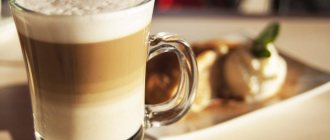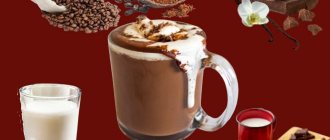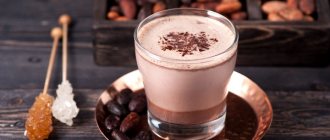For most people on the planet, their mornings begin with an invigorating drink. Freshly brewed Turkish coffee or cocoa at home, hot espresso with you from the nearest cafe on the way to work - it doesn’t matter. Everyone chooses their own, maybe someone even likes orange juice. And for lovers of hot drinks, let’s look at how their beneficial and harmful properties are expressed.
What is the main difference
During the Middle Ages, Spanish travelers brought amazing chocolate beans to Europe, teaching their compatriots how to brew a wonderful spicy drink from them. And 100 years later, the inhabitants of the Old World were amazed by a new sensation - coffee fruits arriving from across the sea. Since then, the world has been divided into two camps: lovers of coffee taste versus fans of cocoa aroma.
How to grow a cocoa tree
In nature, chocolate trees are common in the tropical regions of South America, and cultivated plantations are found in warm and humid regions around the world. African countries produce a significant portion of cocoa bean exports.
The cocoa tree requires certain conditions to grow:
- stable temperature within 20°C;
- high humidity;
- scattered sun rays.
The last factor is ensured by planting cocoa trees under the shade of tall palm trees, and the crown is formed so that they do not grow above 6 m. The plant begins to bear fruit at 5–6 years and continues on average up to 30 years. Patriarchs among cocoa live up to 80 years. The fruits are collected twice a year - before the end and the beginning of the rainy season.
To obtain 1 kg of cocoa powder, you need to process about 40 fruits or 1200 beans.
Child labor is still used on plantations. Large companies that purchase beans are constantly criticized around the world because of this, but they are not going to stop the inhumane practice.
Meanwhile, global production of cocoa beans is growing every year. If in 1965 about 1230 thousand tons were collected worldwide, then by 2010 it had grown to 4230 thousand tons. The African state of Cote d'Ivoire is the leader in cocoa exports.
Cocoa beans
Cocoa contains unique elements that are not found in any other natural product - phenylethylamine and anandamide. The latter has a rather strong effect on the nervous system (cannabinoid properties) and has a stimulating effect.
Interesting fact! Phenylethylamine is the same “chemistry of feelings”. It is this substance that is produced in increased quantities by the body of people in love, causing the heart to beat faster.
In addition, the fruits of the chocolate tree contain a huge amount of useful substances: vitamins (A, B2, B3, E, K, PP), minerals (calcium, zinc, iron, magnesium, phosphorus, potassium, selenium), folic acid (7% of daily requirement per 100 g of drink), polyphenols, theobromine, melanin, essential amino acids, tannins, caffeine in small quantities, etc.
Carefully! Cocoa beans contain purines, which can be deposited in the body in the form of oxalic acid. This can cause aggravation of illness in people with gout, diabetes, or liver and kidney problems.
What is it, chocolate tree
The first Europeans were so fascinated by the taste of the drink made from the fruit of this tree that they named it Theobroma, which translated from ancient Greek meant “food of the gods.” Subsequently, Carl Linnaeus legitimized this name in his scientific classification.
The cocoa, or chocolate tree, is an evergreen tree. It grows in hot areas of South America and is cultivated in hot, humid climates around the world for its seeds, the cocoa bean, the most valuable ingredient in chocolate. The cocoa tree grows up to 12 m in height. The leaves grow alternately, thin, evergreen. Small pink and white flowers grow directly from the trunk and large branches.
The flowers of the cocoa tree are pollinated not by bees, but by small flies - midges.
Cocoa has another interesting feature - its flowers grow not on branches, but on the trunk itself. The fruits are shaped like an elongated lemon with longitudinal grooves. They reach a length of 30 cm and weigh up to 0.5 kg. Inside each fruit there are from 20 to 60 seeds surrounded by whitish, loose pulp. The fruit ripens on average in 4 months.
Coffee beans
Coffee gained its popularity due to its strong invigorating effect. It contains a well-known alkaloid - caffeine, thanks to the large amount of which the fruits of the coffee tree received this name.
Initially, people added beans to food as a seasoning, but then coffee earned the right to be considered a complete food product. A little later they began to prepare a drink from it, first cold and then hot. Here their story with cocoa is a little similar.
In the 21st century, new varieties of coffee appear that are accepted for consumption: green and also decaffeinated.
Is it possible to grow a tree yourself?
So, you have learned what a chocolate tree is, where the plant grows, and how the beans are made. But is it possible to grow it yourself? Although it is a tropical plant, it can be grown in our climate. Don't expect a rich harvest. This tree is very difficult to grow. But if you provide it with suitable climatic conditions and take sufficient care, this exotic plant will delight you and your guests.
Cocoa is grown from seeds. They can be purchased online. Seeds are sown in nutritious, light, breathable soil with a neutral pH. You can use a regular substrate, but it is advisable to aerate it with sand or crushed polystyrene. Cocoa seeds germinate at 20-35°C. But there is no guarantee of germination on the first try. Remember that the substrate must always be moist. After a few weeks, the grown plant should be transplanted into large pots with light, permeable soil.
Cocoa beans are used to produce powder and butter.
Light, humidity
The plant requires high air humidity (up to 90%). Therefore, a shady, damp place suits it. It should also be watered and irrigated frequently (preferably with settled rainwater - hard water is not suitable for it). The ideal place to grow cocoa is near other indoor plants that require high humidity. They will create a favorable microclimate for each other.
Nutrition
The cocoa tree is suitable for fertilizers intended for indoor plants, ideally those with decorative leaves (preferably in lower doses).
Transfer
A tropical tree is replanted in the same way as other indoor plants - best in the spring.
Trimming
Light pruning of the terminal shoots leading to branching should not damage the cocoa tree, but is not necessary. In our climatic conditions, the plant reaches a maximum of 3 m. Unfortunately, there will be no bean harvest when grown at home. But beautiful flowers will definitely please the eye.
Historical reference
As soon as it appeared in Europe, coffee gained a reputation as a medicine. But the most interesting thing is that it was not served to women, who were simply not allowed into coffee shops. The case ended with representatives of the anti-coffee movement even filing a petition against coffee. Fortunately, this matter ended in nothing, so the aromatic drink has safely survived to this day.
Growing coffee on plantations
Rare connoisseurs of the invigorating drink have seen with their own eyes what coffee grows on and know the entire cultivation process. Let's try to recreate pictures from a coffee plantation in words:
- After processing, the seed is placed in temporary greenhouses for germination. Shoots appear after 2.5 months, grown seedlings with the first leaves are transplanted into individual containers and placed in greenhouses.
- The greenhouse growing time for coffee seedlings reaches 6-12 months, then the tree is transplanted to a permanent place. The site should be located in a place protected from bad weather, at an angle to the sun's rays.
- Sometimes farmers use open plantations for seedlings, rightly believing that this method hardens the shoots and adapts them to equatorial conditions. Such areas are lined with tall shrubs to protect them from the burning sun, wind and rain.
After three years, the stronger coffee blooms for the first time. The spectacle is of incredible beauty; the flowers vaguely resemble jasmine. The tree blooms with lightning speed: in three days. The first fruiting is weak. Real harvests begin when coffee plants are 5 years old.
How a mature coffee tree grows and how its fruits are harvested:
- red (less often purple) coffee berries are collected in large elongated clusters;
- The ripening period for coffee berries is 8-11 months (depending on local growing conditions);
- Harvesting by region is carried out at different times: in Brazil - in May-September, in America - in October-March, on African plantations - from October to April;
- under plantation conditions, the growth of the coffee tree does not stop and without pruning it can reach up to 9 meters; pruning is carried out up to 3 meters.
The best yields are from 8-15 year old trees. Fruiting continues longer (up to 50 years), but the quality of the berries is no longer the same. Manual harvesting is complemented by mechanized harvesting. A harvester goes through the plantation and shakes off the coffee clusters, then the fruits are sorted by hand. Machine harvesting is carried out on flat areas with uniform ripening of the berries, so farmers’ hands are often the only tool.
World “coffee belt”: in which regions of the planet coffee is grown
Wild and cultivated coffee trees are grown in 65 countries. They are located along the equator, forming the coffee belt of the planet. It is humid here, there are plenty of solstice days, and there are no temperature changes that are destructive for coffee.
Geographical boundaries of the coffee belt:
- 10 degrees north latitude and 10 degrees south longitude;
- the territory lies in the Tropics of Cancer and Capricorn;
- More than half of the world's plantations are located in Central and South America, followed by Africa, and Southeast Asia closes the list.
American continent. High quality grains are produced in Brazil, Colombia, and Peru. There are productive plantations in Ecuador, Guiana, Paraguay, Bolivia, and Venezuela.
Africa. The air here is drier, there is a lot of sun. Coffee plantings are cultivated in Ethiopia, Uganda, Kenya, Uganda, Zimbabwe, Angola, and Congo. Asian countries have good market positions - fruits are grown and harvested in Vietnam, Indonesia, and India
The production of the drink from imported raw materials is carried out far beyond the equator. Varietal black and green coffee from roasted beans is obtained in Italy, Turkey, Russia, China, and the countries of Southeast Asia.
Why drinks are good for your health
Chocolate fans believe that cocoa or hot chocolate is much healthier than coffee, because even children can drink it, but each product has positive and negative qualities.
It’s useful to know, read: – How to choose good cocoa and how to distinguish natural cocoa by quality.
Coffee
- Increases performance
Caffeine raises blood pressure, is very invigorating, stimulates cardiovascular activity, and activates the central nervous system. In such an upbeat mood, any person is capable of moving mountains.
- Improves brain function, attention, memory, enhances concentration abilities
Thanks to this, coffee can be considered a product that slows down the aging of brain cells, as well as prevents Alzheimer's and Parkinson's diseases.
- Has a beneficial effect on the functioning of the digestive system
In addition to its invigorating effect, caffeine has the property of increasing stomach acidity and speeding up the digestion of food.
- Speeds up metabolism
This excellent quality improves your well-being and, among other things, allows you to quickly lose weight. Very relevant for girls who want to get rid of a couple of extra pounds.
Helpful advice! However, you should not rely too much on coffee, because it does not have a fat-burning effect. So change your diet to a more dietary one and join the gym.
- Relieves pain in asthmatics
Caffeine is a bronchodilator, so it is good against shortness of breath, cough, and wheezing. Its action is similar to theophylline, a bronchodilator found in medications to relieve asthma symptoms.
Important! Asthmatics should not drink coffee before undergoing tests to determine the severity of the disease, because. caffeine may skew the readings.
- Prevents liver cirrhosis
This property of the drink was discovered by legendary British scientists. The same ones who constantly analyze something, giving us a hundred useful discoveries per day. So, they experimentally found that two cups of coffee a day is enough to reduce the risk of developing liver disease by 50%.
Recent studies confirm that a small amount of coffee does not threaten the functioning of the cardiovascular system (for example, the development of tachycardia or the occurrence of coronary heart disease), but, nevertheless, it still carries some harm.
The most common health problems caused by coffee are increased cholesterol levels and leaching of calcium from bone tissue.
It’s useful to know, read: – How to make delicious coffee with cocoa: cinnamon, Romanian, Hollywood and others.
Cocoa
- Natural antidepressant
Cocoa activates increased production of endorphin in the corresponding glands, which quickly tones the body. And tryptophan, which is part of it, improves mood, helping to cope with apathy and depression.
- Contains natural antioxidants
Chocolate drink is a rich source of polyphenols. They improve the functioning of the circulatory system, increase the proportion of “correct” cholesterol in the blood, and reduce the risk of inflammation.
Note: processing beans with alkaline compounds (alkalization process) reduces their beneficial properties: the flavonol content is reduced by more than half, by as much as 60%. So it is better to give preference to natural organic products without any processing.
- Reduces blood pressure
This property of cocoa was discovered by doctors in South America by comparing health indicators among drink drinkers and those who did not drink it. This is also the merit of the flavonoids contained there, because they improve the condition of the walls and patency of blood vessels due to the increased production of nitric oxide in the body.
Useful advice for those who like to have fun! Thanks to these same properties, cocoa is a good hangover reliever. So maybe a cup of chocolate in the morning instead of pickle juice?
- Reduces the risk of cardiovascular diseases
Regular consumption of the drink within reasonable limits reduces the risk of a heart attack or stroke. Cocoa thins the blood, so its effect on the body is similar to that of aspirin.
- Increases brain activity
Improving blood flow and vascular health also reduces the risk of brain diseases. Flavonoids in the drink are directly involved in the generation of new neural cells.
Medical fact! A daily cup of cocoa prevents the onset of Parkinson's and Alzheimer's diseases, enhancing mental abilities even in people with mental disorders.
- Improves skin condition and health
Cocoa contains melanin, which is responsible for the beauty and youth of the skin, helps strengthen its cells and gives elasticity to the structure. In addition, it protects the skin from the harmful effects of ultraviolet rays from the sun.
- Antidiabetic effect
Flavonoids slow down the absorption of simple carbohydrates in the intestines. They significantly improve the functioning of the pancreas and enhance insulin production, as well as stimulate absorption.
Be careful! Everything is good and everything is poison. Excessive consumption of cocoa, especially with milk and sugar, most often causes a sharp jump in blood sugar levels.
- Removes lactic acid from muscles
It accumulates in tissues due to poor circulation. Cocoa improves the condition of blood vessels and increases blood flow, which “washes out” the byproduct of physical activity from muscle fibers and relieves discomfort, pain and burning.
History of the drink
Archaeologists believe that the Mayans consumed cocoa as early as 500 BC. e. and may not have been its discoverers. To make the drink, Indians ground the seeds into a paste and mixed it with water, cornmeal, chili peppers and other spices. Then the mixture was poured from vessel to vessel until a thick foam formed. Since sugar had not yet arrived in America at that time, Mayan cocoa had a completely different taste and was served cold.
When, in the 16th century, having defeated the warriors of Montezuma, the great conqueror Cortes returned to Spain, he brought with him their famous cocoa beans, as well as all the equipment for preparing the chocolate drink, as a trophy. Gradually, cocoa gained recognition in Europe and became a fashionable treat, popular among the Spanish upper class. Cocoa even began to be added to dowries when members of the Spanish royal family married other European aristocrats. In the rest of Europe at that time, chocolate was highly valued and expensive because cocoa beans grew only in South America, from where the Spaniards brought them.
Already by the 17th century, cocoa acquired the sweet taste characteristic of our days, but for a long time remained a drink accessible only to the highest social strata of Europe.
In 1828, the Dutchman Conrad Johannes van Houten developed the first machine for producing cocoa powder. His press allowed the fatty cocoa butter to be separated from pure chocolate powder, which was much easier to add to milk and water. Soon after this, solid chocolate appeared, but that's another story.
How to cook properly
If there are no contraindications to drinking coffee and cocoa, make a delicious mix of these two products - aromatic moccacino. This chocolate-flavored coffee drink with an Italian name, invented in America relatively recently, is a type of latte.
Each coffee shop prepares it a little differently; all moccacino recipes have one thing in common - it always contains 3 main products: coffee, cocoa, milk.
Step by step recipe:
- We brew any delicious strong coffee.
- Prepare a milk-chocolate mixture (1 teaspoon cocoa powder, 50 ml milk 3.5% fat + 50 ml cream 15% fat, sugar or powdered sugar to taste).
- Whip cold cream.
- We assemble the drink in layers: pour cocoa, then coffee, put whipped cream on top, and finally sprinkle with cocoa powder ground with powdered sugar.
You can add any spices and herbs to the base drink, for example, cinnamon, cardamom, decorate with ice cream, chocolate, candied fruits, etc. Turn on your imagination and create!
What is the difference between hot chocolate and cocoa?
Hot chocolate is made from melted chocolate bars (or chocolate chips) exclusively in milk with the addition of vanilla, sugar, cinnamon and whipped until foamy. A more inexpensive and easy-to-prepare drink, usually called cocoa, is brewed with water or milk from cocoa powder.
Interesting materials:
What does the word soar mean? What does the word Pentagon mean? What does the word perinatal mean? What does the word by inspiration mean? What does the word preamble mean? What does the word preposition mean? What does the word prefix mean? What does the word give mean? What does the word pleasant mean? What does the word project mean?
Coffee or cocoa: which is better and which is healthier?
Cocoa invigorates well, without causing an increase in blood pressure, without harm to the cardiovascular system. Therefore, it can be drunk without fear by patients predisposed to tachycardia, arrhythmia or hypertension.
Coffee is lower in calories and can be consumed by diabetics and overweight people, of course, in moderation without adding sugar, sweet syrups or heavy cream.
The main thing is to choose high-quality raw materials from reliable manufacturers. When purchasing coffee beans or cocoa powder, analyze the composition on the packaging and check the expiration date, then the drink will definitely turn out to be the most delicious and healthy.
Coffee and cocoa are very different products, both have valuable qualities and contraindications. You can definitely decide for yourself “for or against” by objectively assessing your state of health, well-being and personal taste preferences. In moderation, everyone can afford any of the drinks without harm to health.
Bon appetit!
Chocolate tree varieties
There are several types of cocoa tree. They differ from each other in the taste of the beans and the subtleties of agricultural technology:
- Criollo is a rare variety that grows only in Central America and Mexico. Criollo is difficult to grow due to many diseases. Criollo chocolate has a pleasant aroma and a delicate nutty flavor.
- National is produced only in South America. Products from this variety of beans have specific taste qualities and are rare, since the trees grow in a limited area and are also susceptible to diseases.
- Trinitario. The variety was obtained by crossing two species - Criollo and Forastero. Distributed throughout the world, as the beans have excellent taste and the trees are resistant to disease.
- Forastero is the most famous variety, accounting for up to 80% of the world's production. The trees grow quickly and bear fruit abundantly. Chocolate of this variety is distinguished by a characteristic bitter note with a sour tint.
For MODERATE coffee consumption:
- attention and performance improves,
- the risk of depression is reduced,
- acceleration of metabolism and, as a result, getting rid of excess weight (provided you consume natural coffee without adding cream, sugar, syrups. Otherwise, you will, on the contrary, be able to gain a couple of extra pounds),
- the secretory functions of the stomach are improved,
- reduces the risk of liver cirrhosis.
- But we should not forget about contraindications. People suffering from arrhythmia, tachycardia and coronary heart disease should avoid coffee. In addition, it is recommended to use this drink with caution for people suffering from diabetes, because caffeine increases cholesterol levels and can also be addictive.
So, we can come to the conclusion that drinking natural coffee in its pure form, but less than 2-3 cups per day, will have a faster beneficial effect on the body.
Possible harm
Despite many beneficial properties, in some cases cocoa powder can be harmful. Due to the presence of caffeine in its composition, it is not recommended to use the product for nervous disorders and insomnia. You should not drink cocoa at night, especially for children. This product is contraindicated for children under 3 years of age.
During pregnancy, it is better not to consume cocoa-containing products. They interfere with the normal absorption of calcium, which is necessary for the development and growth of the fetus. But when planning pregnancy, cocoa powder will be beneficial. It contains a lot of folic acid, and it ensures the proper formation of the nervous system at an early stage of development of the body. For the expectant mother, cocoa-containing treats will lift her spirits, help her calm down and prepare for a new stage in her life.
If you have gout, you should exclude foods that contain cocoa powder from your diet. It contains purines, under the influence of which salts are deposited in the joints.
Allergy to cocoa is common, so if you are prone to this disease, it is better to avoid cocoa-containing products. It is not recommended to use them for atherosclerosis and constipation.
Compare the selected products according to the composition of macroelements and microelements, vitamins and other substances. —>
Toxicity and contraindications
Now we understand the benefits of cocoa powder.
And toxicity for health cannot be ignored either. There are also contraindications
In most cases, cocoa causes toxicity in two ways:
- If used in excess.
- When consuming a low-quality product.
Where is there more caffeine, in coffee or cocoa? Naturally, in coffee. But cocoa also contains it. The drink contains 0.2% caffeine, which can adversely affect the condition of small children, pregnant women and people who have contraindications to caffeine.
Due to the presence of purines, it is better to limit the consumption of the drink to people who have kidney problems and gout. The prerequisite for this is the accumulation of uric acid and the deposition of salts in the joints.
In areas where cocoa trees are grown, sanitary requirements are not high enough. The consequence of this is the presence of insects and microbes in the fruits. To disinfect trees, they are treated with toxic substances and chemicals in huge quantities. In some cases, exotic insects can be ground together with the raw materials during the processing process. Then there is a high possibility of an allergic reaction. Cocoa beans themselves do not contain allergens, but manufacturers of low-quality, high-quality powders use various chemical additives, which in most cases become a prerequisite for the appearance of allergies.
Since the answer to the question of whether there is caffeine in cocoa is yes, the drink is contraindicated for the following categories of people:
- Children under 3 years of age.
- People suffering from diabetes, diarrhea, atherosclerosis.
- People suffering from joint diseases.
- Pregnant and lactating ladies.
- Overweight people.
- People with high stomach acidity.











